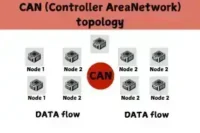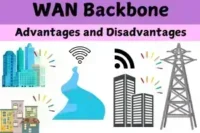Advantages and Disadvantages of Bus Topology
Published: February 13, 2025
Have you ever wondered why some networks use a single cable to connect all devices while others rely on multiple connections? Bus topology is a network setup where everything is linked to one central line. But is it the most efficient option for all businesses?

What is Bus Topology?
Bus topology is a network design where all devices (computers, printers, servers) are connected to a single central cable, the bus or backbone. This cable acts as the primary communication channel, transmitting data between devices. Each device listens for data meant for it while ignoring other transmissions. Terminators at both ends of the cable prevent signal interference.
It is a simple and cost-effective network structure, but its main drawback is that the entire network goes down if the central cable fails.
Examples of Bus Topology
Here are some examples of networks that have used bus topology:
- Ethernet (10Base-2 and 10Base-5) – Early Ethernet networks used a bus topology with coaxial cables.
- LocalTalk (Apple) – Apple’s older networking system used a bus structure.
- ARCNET (Attached Resource Computer Network) – An early LAN technology based on bus topology.
- Token Bus (IEEE 802.4) – A network protocol used in industrial applications.
- Military and Industrial Control Systems – Some legacy systems still use bus topology for communication.
Advantages of Bus Topology
Star topology offers several pros of bus topology that make it an excellent networking solution. Below are some of the advantages of bus topology that contribute to its popularity:

- Quick and Hassle-Free Installation
- Budget-Friendly Network Setup
- Smooth and Reliable Data Flow
- Easily Expandable for Growth
- Operates Without Extra Power Supply
- Flexible and Adaptable Structure
- Straightforward Maintenance and Repairs
- Organized Connection of Devices
- Well-suited for Local Area Networks
- Minimal Cabling for Efficient Setup
- Seamless Addition and Removal of Devices
Let’s find out how the advantages of bus topology help make everything more efficient for us.
1. Quick and Hassle-Free Installation
Bus topology is easy to set up because it requires minimal cabling. Devices are connected along a single cable, making installation straightforward and time-efficient.
2. Budget-Friendly Network Setup
Bus topology is cost-effective because it requires fewer cables and hardware components than other topologies. Small businesses and home networks can implement it without significant expenses.
3. Smooth and Reliable Data Flow
Bus topology ensures efficient data transmission in a small network with minimal devices. Data moves in a linear fashion along the cable, reducing congestion when traffic is low.
4. Easily Expandable for Growth
Additional devices can be added to the network with minimal effort. Expanding the network is simple as long as the backbone cable has enough capacity.
5. Operates Without Extra Power Supply
Bus topology doesn’t require additional networking hardware like switches or hubs, reducing power consumption and operational costs.
6. Flexible and Adaptable Structure
This topology is adaptable to various networking needs. It supports temporary connections, making it useful for quick setups and testing environments.
7. Straightforward Maintenance and Repairs
Maintaining a bus topology is more straightforward than maintaining a complex network design because it has fewer components. Faults can be identified quickly, especially in small setups.
8. Organized Connection of Devices
All devices share the same communication channel, ensuring an organized structure without excessive cabling.
9. Well-suited for Local Area Networks (LANs)
Bus topology works efficiently for small LANs, such as office networks or classrooms, with fewer connected devices.
10. Minimal Cabling for Efficient Setup
Unlike mesh or star topologies, bus topology requires less cabling, reducing material costs and installation complexity.
11. Seamless Addition and Removal of Devices
Devices can be connected or disconnected from the main cable without affecting the entire network, making modifications easy.
Disadvantages of Bus Topology
While star topology is highly efficient, some limitations should be considered before implementation.

- Single Failure Can Disrupt the Network
- Primary Cable Failure Causes Network Disruption
- Limited Cable Length Restrictions
- Prone to Noise and Signal Interference
- Potential Security Vulnerabilities
- High Risk of Packet Loss in Data Transfer
- Slower Compared to Alternative Topologies
- Messages Can Travel One at a Time
- Adding More Devices Can Slow Performance
- Not Suitable for Large-Scale Networks
- Challenging to Manage Efficiently
- Troubleshooting Individual Devices is Complex
- Terminators Required for Proper Functioning
- High Maintenance Costs Over Time
Let’s break down the disadvantages of bus topology and explore the limitations you should consider.
1. Single Failure Can Disrupt the Network
Since all devices depend on a single backbone cable, any failure in the cable can disrupt network communication.
2. Main Cable Failure Causes Network Disruption
The entire network is affected if the central cable breaks, causing downtime until repairs are made.
3. Limited Cable Length Restrictions
The length of the backbone cable determines the network’s size. If the cable is too long, signal degradation may occur, limiting scalability.
4. Prone to Noise and Signal Interference
Electromagnetic interference (EMI) from other electronic devices can disrupt signals, leading to data transmission errors.
5. Potential Security Vulnerabilities
Since all devices share the same communication line, unauthorized access or data interception is easier in switched networks than in fixed networks.
6. High Risk of Packet Loss in Data Transfer
Collisions can occur when multiple devices attempt to send data simultaneously, resulting in data loss and retransmission delays.
7. Slower Compared to Alternative Topologies
Data packets travel through the entire cable in a bus topology, slower than point-to-point networks like star topology.
8. Messages Can Travel One at a Time
Only one device can send data at a time, creating bottlenecks in more extensive networks with heavy traffic.
9. Adding More Devices Can Slow Performance
Network performance decreases due to increased collisions and congestion as more devices are connected.
10. Not Suitable for Large-Scale Networks
Bus topology works well for small networks but struggles with high traffic loads in larger setups.
11. Challenging to Manage Efficiently
Monitoring network performance and troubleshooting connectivity issues can be difficult due to the shared communication channel.
12. Troubleshooting Individual Devices is Complex
Identifying a faulty device or connection is challenging, as all devices are linked to the same cable.
13. Terminators Required for Proper Functioning
Terminators must be placed at both ends of the backbone cable to prevent signal reflection and data transmission errors.
14. High Maintenance Costs Over Time
Although initial setup costs are low, long-term maintenance, troubleshooting, and potential replacements can increase costs over time.
Conclusion
Bus topology is a simple network design where all devices share a single cable. It is cost-effective and easy to set up, making it ideal for small networks. However, it has drawbacks, such as slow performance with high traffic and a single point of failure if the main cable is damaged. Understanding these points helps in making better network choices.
Choosing the proper network setup is crucial for smooth performance. While bus topology works well for small networks, it may not be the best for larger setups. If you’re planning a network, explore different topologies and pick what best suits your needs our needs best. The right choice will ensure a stable and efficient system!
FAQs About Advantages and Disadvantages of Bus Topology
Bus topology is rarely used in modern networks because newer designs like star and mesh are more reliable. However, it is still found in small, temporary, or specialized networks.
It is outdated because a single cable failure can break the entire network. Also, it becomes slow when many devices are connected.
No terminators are necessary to prevent data from bouncing back. Without them, signals interfere, causing network failures.
Yes, it is one of the cheapest because it uses less cable and no central device. However, maintenance costs can increase if issues occur.
When many devices share the same cable, data transfer slows down. High traffic can cause delays and collisions.
If a single device fails, the rest of the network works. But if the main cable is damaged, the entire network stops.
You can add more devices, but it may slow down performance. Too many connections can lead to network congestion.
Finding a fault is hard because all devices share the same cable. You have to check the entire cable to locate the problem.
No, it works best for small setups. Large networks need more substantial and faster designs like star or mesh.
Bus topology is cheaper but less reliable. Star topology is more stable because one device’s failure doesn’t affect others.





